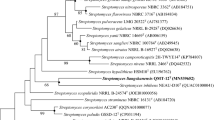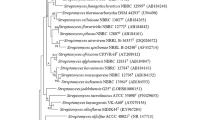Abstract
A novel actinobacterium, designated strain NEAU-QY24T, was isolated from the rhizosphere of corn (Zea mays L.). A polyphasic approach was employed to determine the taxonomic status of strain NEAU-QY24T. The isolate was found to have chemical and morphological properties of the genus Streptomyces, with high 16S rRNA gene sequence similarity to Streptomyces lanatus JCM 4332T (98.3%) and clustered phylogenetically with Streptomyces lannensis JCM 16578T (98.2%). The cell wall was found to contain meso-diaminopimelic acid and the whole cell sugars were identified as glucose and ribose. The predominant menaquinones were identified as MK-9(H6), MK-9(H4) and MK-9(H8). The phospholipid profile was found to consisted of diphosphatidylglycerol, phosphatidylethanolamine and phosphatidylinositol. The major fatty acids were identified as iso-C16:0, C16:0, anteiso-C17:0 and C15:0. A combination of DNA–DNA hybridization experiments and phenotypic tests were carried out between strain NEAU-QY24T and its closely related strains, which clarified their relatedness and demonstrated that strain NEAU-QY24T could be distinguished from these strains. These data indicate that the isolate should be recognised as a new species of the genus Streptomyces, for which the name Streptomyces flavalbus sp. nov. is proposed. The type strain is NEAU-QY24T (= CGMCC 4.7400T = DSM 104539T).


Similar content being viewed by others
References
Collins MD (1985) Chemical Methods in Bacterial Systematics. In: Goodfellow M, Minnikin DE (eds) Isoprenoid quinone analyses in bacterial classification and identification. Academic Press, London, pp 267–284
De Ley J, Cattoir H, Reynaerts A (1970) The quantitative measurement of DNA hybridization from renaturation rates. Eur J Biochem 12:133–142
Felsenstein J (1981) Evolutionary trees from DNA sequences: a maximum likelihood approach. J Mol Evol 17:368–376
Felsenstein J (1985) Confidence limits on phylogenies: an approach using the bootstrap. Evolution 39:783–791
Gallagher KA, Fenical W, Jensen PR (2010) Hybrid isoprenoid secondary metabolite production in terrestrial and marine actinomycetes. Curr Opin Biotechnol 6:794–800
Gao RX, Liu CX, Zhao JW, Jia FY, Yu C, Yang LY, Wang XJ, Xiang WS (2014) Micromonospora jinlongensis sp. nov., isolated from muddy soil in China and emended description of the genus Micromonospora. Antonie Van Leeuwenhoek 105:307–315
Gordon RE, Barnett DA, Handerhan JE, Pang C (1974) Nocardia coeliaca, Nocardia autotrophica, and the nocardin strain. Int J Syst Bacteriol 24:54–63
Hatano K, Nishii T, Kasai H (2003) Taxonomic re-evaluation of whorl-forming Streptomyces (formerly Streptoverticillium) species by using phenotypes, DNA-DNA hybridization and sequences of gyr B, and proposal of Streptomyces luteireticuli (ex Katoh and Arai 1957) corrig., sp. nov., nom. rev. Int J Syst Evol Microbiol 53:1519–1529
Hayakawa M, Nonomura H (1987) Humic acid-vitamin agar, a new medium for the selective isolation of soil actinomycetes. J Ferment Technol 65:501–509
Huss VAR, Festl H, Schleifer KH (1983) Studies on the spectrometric determination of DNA hybridization from renaturation rates. Syst Appl Microbiol 4:184–192
Jones KL (1949) Fresh isolates of actinomycetes in which the presence of sporogenous aerial mycelia is a fluctuating characteristic. J Bacteriol 57:141–145
Kämpfer P (2012) Genus I Streptomyces. In: Goodfellow M, Kämpfer P, Busse H-J, Trujillo ME, Suzuki K-I, Ludwig W, Whitman WB (eds) Bergey’s manual of systematic bacteriology, vol 5, 2nd edn. The Actinobacteria, Part B. Springer, New York, pp 1455–1767
Kelly KL (1964) Inter-society colour council-national bureau of standards colour-name charts illustrated with centroid colours. US Government Printing Office, Washington
Kim SB, Brown R, Oldfield C, Gilbert SC, Iliarionov S, Goodfellow M (2000) Gordonia amicalis sp. nov., a novel dibenzothiophene-desulphurizing actinomycete. Int J Syst Evol Microbiol 50:2031–2036
Kim KO, Shin KS, Kim MN, Shin KS, Labeda DP, Han JH, Kim SB (2012) Reassessment of the status of streptomyces setonii and reclassification of streptomyces fimicarius as a later synonym of streptomyces setonii and streptomyces albovinaceus as a later synonym of streptomyces globisporus based on combined 16S rRNA/gyrB gene sequence analysis. Int J Syst Evol Microbiol 62(Pt 12):2978
Kimura M (1980) A simple method for estimating evolutionary rates of base substitutions through comparative studies of nucleotide sequences. J Mol Evol 16:111–120
Koshy A, Dhevendaran K, Georgekutty MI, Matarajan P (1997) L-Asparaginase activity in Streptomyces plicatus isolated from the alimentary canal of the fish, Gerres filamentous (Cuvier). J Mar Biotechnol 5:181–185
Labeda DP (2011) Multilocus sequence analysis of phytopathogenic species of the genus Streptomyces. Int J Syst Evol Microbiol 61:2525–2531
Labeda DP, Dunlap CA, Rong X, Huang Y, Doroghazi JR, Ju KS, Metcalf WW (2017) Phylogenetic relationships in the family streptomycetaceae, using multi-locus sequence analysis. Antonie Van Leeuwenhoek 110(4):563–583
Lechevalier HA, Lechevalier MP (1970a) A critical evaluation of the genera of aerobic actinomycetes. In: Prauser H (ed) The actinomycetes. Gustav Fischer, Jena, pp 393–405
Lechevalier MP, Lechevalier HA (1970b) Chemical composition as a criterion in the classification of aerobic actinomycetes. Int J Syst Bacteriol 20:435–443
Lechevalier MP, Lechevalier HA (1980) The chemotaxonomy of actinomycetes. In: Dietz A, Thayer DW (eds) Actinomycete taxonomy special publication, vol 6. Society of Industrial Microbiology, Arlington, pp 227–291
Lechevalier MP, De Bièvre C, Lechevalier HA (1977) Chemotaxonomy of aerobic actinomycetes: phospholipid composition. Biochem Syst Ecol 5:249–260
Luo X, Liang K, Wang Y, Wan C, Zhang L (2017) Streptomyces luteus sp. Nov. a novel actinomycete isolated from Loulan soil of Xinjiang, China. Int J Syst Evol Microbiol 67(3):543
Mandel M, Marmur J (1968) Use of ultraviolet absorbance temperature profile for determining the guanine plus cytosine content of DNA. Methods Enzymol 12:195–206
McKerrow J, Vagg S, McKinney T, Seviour EM, Maszenan AM, Brooks P, Se-viour RJ (2000) A simple HPLC method for analysing diaminopimelic acid diastereomers in cell walls of Gram-positive bacteria. Lett Appl Microbiol 30:178–182
Minnikin DE, Hutchinson IG, Caldicott AB, Goodfellow M (1980) Thin-layer chromatography of methanolysates of mycolic acid-containing bacteria. J Chromatogr 188:221–233
Minnikin DE, O’Donnell AG, Goodfellow M, Alderson G, Athalye M, Schaal K, Parlett JH (1984) An integrated procedure for the extraction of bacterial isoprenoid quinones and polar lipids. J Microbiol Methods 2:233–241
Promnuan Y, Kudo T, Ohkuma M, Chantawannakul P (2013) Streptomyces chiangmaiensis sp. nov. and Streptomyces lannensis sp. nov. isolated from the South-East Asian stingless bee (Tetragonilla collina). Int J Syst Evol Microbiol 63:1896–1901
Rosselló-Móra R, Trujillo ME, Sutcliffe IC (2017) Introducing a digital protologue: a timely move towards a database-driven systematics of archaea and bacteria. Antonie Van Leeuwenhoek 110(4):455–456
Saitou N, Nei M (1987) The neighbor-joining method: a new method for reconstructing phylogenetic trees. Mol Biol Evol 4:406–425
Shibazaki A, Omoto Y, Kudo T, Yaguchi T, Saito A, Ando A, Mikami Y, Gonoi T (2011) Streptomyces coacervatus sp. nov. isolated from the intestinal tract of Armadillidium vulgare. Int J Syst Evol Microbiol 61:1073–1077
Shirling EB, Gottlieb D (1966) Methods for characterization of Streptomyces species. Int J Syst Bacteriol 16:313–340
Smibert RM, Krieg NR (1994) Phenotypic characterisation. In: Gerhardt P, Murray RGE, Wood WA, Krieg NR (eds) Methods for general and molecular bacteriology. American Society for Microbiology, Washington, pp 607–654
Také A, Matsumoto A, Omura S, Takahashi Y (2015) Streptomyces lactacystinicus sp. nov. and Streptomyces cyslabdanicus sp. nov. producing glactacystin and cyslabdan, respectively. J Antibiot 68:1–6
Tamura K, Stecher G, Peterson D, Filipski A, Kumar S (2013) MEGA6: molecular evolutionary genetics analysis version 6.06. Mol Biol Evol 30:2725–2729
Tanasupawat S, Phongsopitanun W, Suwanborirux K, Ohkuma M, Kudo T (2015) Streptomyces actinomycinicus sp. nov. isolated from Thai peat swamp forest soil. Int J Syst Evol Microbiol 1:124–125
Waksman SA (1961) The actinomycetes. Classification, identification and descriptions of genera and species, vol 2. Williams and Wilkins, Baltimore
Waksman SA (1967) The Actinomycetes. A summary of current knowledge. Ronald Press, New York
Waksman SA, Henrici AT (1943) The nomenclature and classification of the actinomycetes. J Bacteriol 46:337–341
Wang Y, Lu Z, Wu H, Lv F (2009) Study on the antibiotic activity of microcapsule curcumin against foodborne pathogens. Int J Food Microbiol 136(1):71–74
Wayne LG, Brenner DJ, Colwell RR, Grimont PAD, Kandler O, Krichevsky MI, Moore LH, Moore WEC, Murray RGE (1987) International Committee on Systematic Bacteriology. Report of the ad hoc committee on reconciliation of approaches to bacterial systematics. Int J Syst Bacteriol 37:463–464
Williams ST, Goodfellow M, Alderson G (1989) Genus Streptomyces Waksman and Henrici 1943, 339AL. In: Williams ST, Sharpe ME, Holt JG (eds) Bergey’s manual of systematic bacteriology, vol 4. Williams and Wilkins, Baltimore, pp 2452–2492
Wu C, Lu X, Qin M, Wang Y, Ruan J (1989) Analysis of menaquinone compound in microbial cells by HPLC. Microbiology 16:176–178
Xiang WS, Liu CX, Wang XJ, Du J, Xi LJ, Huang Y (2011) Actinoalloteichus nanshanensis sp. nov., isolated from the rhizosphere of a fig tree (Ficus religiosa). Int J Syst Evol Microbiol 61:1165–1169
Xiao J, Wang Y, Luo Y, Xie SJ, Ruan JS, Xu J (2009) Streptomyces avicenniae sp. nov. a novel actinomycete isolated from the rhizosphere of the mangrove plant avicennia mariana. Int J Syst Evol Microbiol 59(10):2624–2628
Xie QY, Lin HP, Li L, Brown R, Goodfellow M, Deng Z, Hong K (2012) Verrucosispora wenchangensis sp. nov., isolated from mangrove soil. Antonie Van Leeuwenhoek 102:1–7
Yamamura H, Ashizawa H, Hamada M, Hosoyama A, Komaki H, Otoguro M, Tamura T, Hayashi Y, Nakagawa Y, Ohtsuki T, Fujita N, Ui S, Hayakawa M (2014) Streptomyces hokutonensis sp. nov. a novel actinomycete isolated from the strawberry root rhizosphere. J Antibiot 67:465–470
Yokota A, Tamura T, Hasegawa T, Huang LH (1993) Catenuloplanes japonicas gen. nov., sp. nov., nom. rev., a new genus of the order Actinomycetales. Int J Syst Bacteriol 43:805–812
Yoon SH, Ha SM, Kwon S, Lim J, Kim Y, Seo H, Chun J (2017) Introducing EzBioCloud: a taxonomically united database of 16S rRNA and whole genome assemblies. Int J Syst Evol Microbiol 67:1613–1617
Zucchi TD, Kim BY, Kshetrimayum JD, Weon HY, Kwon SW, Goodfellow M (2012) Streptomyces brevispora sp. nov. and streptomyces laculatispora sp. nov. actinomycetes isolated from soil. Int J Syst Evol Microbiol 62(Pt 3):478
Acknowledgements
This work was supported in part by grants from the National Natural Science Foundation of China (No. 31471832), Chang Jiang Scholar Candidates Program for Provincial Universities in Heilongjiang (CSCP).
Author information
Authors and Affiliations
Corresponding authors
Ethics declarations
Conflict of interest
The authors declare that they have no conflict of interest.
Ethical approval
This article does not contain any studies with human participants and/or animals performed by any of the authors. The formal consent is not required in this study.
Electronic supplementary material
Below is the link to the electronic supplementary material.
Rights and permissions
About this article
Cite this article
Cao, T., Shen, Y., Zhao, J. et al. Streptomyces flavalbus sp. nov., an actinobacterium isolated from rhizosphere of maize (Zea mays L.). Antonie van Leeuwenhoek 111, 1047–1054 (2018). https://doi.org/10.1007/s10482-017-1004-6
Received:
Accepted:
Published:
Issue Date:
DOI: https://doi.org/10.1007/s10482-017-1004-6




